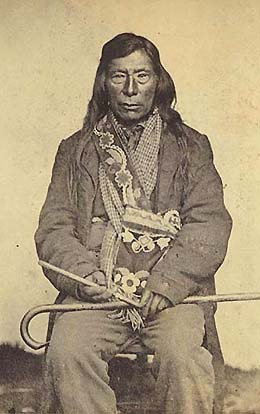Chief Lawyer “Hal-hal-hoot-soot” was the son of a Salish speaking Flathead woman and Twisted Hair, the Nez Perce man who welcomed and befriended Lewis and Clark in the fall of 1805. He was designated as Head Chief of the Nez Perce for the signing of the 1855 and controversial 1863 Treaty.
Hallalhotsoot’s father had positive experiences with the white explorers, which greatly influenced Lawyer. He firmly believed that the best prospect for the future of the Nez Perce was through friendship with non-native peoples.
 “Lawyer” was a nickname given to Hallalhotsoot by the mountain men of the early 1830s. He was known as “the talker,” and his speaking abilities and wisdom enabled him to influence both native and non-native peoples.
“Lawyer” was a nickname given to Hallalhotsoot by the mountain men of the early 1830s. He was known as “the talker,” and his speaking abilities and wisdom enabled him to influence both native and non-native peoples.
The Nez Perce and Christianity
In 1831, six Nez Perce embarked on a journey through the Rocky Mountains to invite Christian teachers to come to the tribes. Two of the party turned back at the mountains, but four proceeded on to St. Louis. The story was reprinted widely in American newspapers, and set off a frenetic missionary movement to the West, one that changed the course not only of the Nez Perce people, but of the entire Northwest.
One of these missionaries, Marcus Whitman, hired Lawyer to live at his mission and teach him the Salish and Nez Perce languages. Whitman provided food and clothing to Lawyer’s family in return. It was here that Lawyer, once a buffalo hunter, began to adapt to the culture and religion of the white man.
Lawyer emerged as a leader of the Nez Perce following the Whitman tragedy on November 29, 1847. He traveled to Salem to meet Joseph Lane, Governor of the Oregon Territory, and requested aid in the capture of the Whitmans’ murderers.
The Walla Walla Treaty Council of 1855
Lawyer’s friendly attitude toward white culture led Isaac Stevens to select him as the designated leader of the Nez Perce at the Walla Walla Treaty Council of 1855. Lawyer was one of the first chiefs to be sketched by the artist Gustav Sohon at that council, an indication of his importance among non-Native observers.
Sohon’s inscription describes Lawyer as Head Chief of the Nez Perce Tribe, but some observers believe he only became the main spokesman after being selected by Isaac Stevens.
After the Council In the years that followed the Walla Walla Council, Lawyer was widely ridiculed by anti-treaty groups within the Nez Perce tribe after the terms of the treaties failed to be honored by the U.S. government. When the promised payments began arriving in the early 1860s, cynical observers would note that they seemed timed to coincide with the government’s desire for more land from the Nez Perce.
The second treaty, signed by Lawyer in 1863, reduced the area of the tribe’s reservation by 90 percent, transferring away the homelands of many Nez Perce bands. This was done without their Lawyer defended his actions by arguing that resisting white encroachment was useless and that the wise and practical course was to simply adapt to changing circumstances.
Despite his trust that Governor Stevens and the American government had good intentions, Lawyer experienced great disappointment when promises made in the treaties were not honored.
In a speech delivered in the goldrush boomtown of Lewiston, Idaho, in 1864, Lawyer spoke eloquently to the failure of the government to live up to its promises:
If [Stevens] had told us that the reservation was to be flooded with white settlers, or that the saw mill was to be used for the exclusive benefit of the Whites, we would never have consented to the treaty. That flour mill and saw mill were pledged to me and my people. All the stipulations of that treaty were pledged to us for our benefit.>br?>br> Nine years have passed and those stipulations are unfulfilled.
[W]e have no church as promised; no schoolhouse as promised; no doctor as promised; no gunsmith as promised; no blacksmith as promised.
Lawyer devoted his life to making peace with the white population and following the terms of the treaties he signed. Nevertheless, in 1870—after holding his post for twenty-five years—he voluntarily stepped down from the leadership of the Nez Perce.
His descendants tell the tale of his death on January 3, 1876, in this manner:
It was Lawyer’s custom to fly his American flag from a pole in front of his lodge or house. On the day that he died, knowing that his end was near, he instructed some member to gradually pull down the flag.
The flag would be lowered a bit and then Lawyer, after a time would say: “Pull it down a little more.” So the flag was lowered a little more. This was repeated several times and when the flag touched the ground, Lawyer died.
Today many Nez Perce people continue to live in their homeland- some on and some off the reservation. Others have moved to cities around the country.
Sources:
Drury, Clifford M. Chief Lawyer of the Nez Perce Indians, 1796-1876 . Glendale, CA: The Arthur H. Clark Company, 1979.
Josephy, Alvin M. The Nez Perce Indians and the Opening of the Northwest (American Heritage Library).New York: Houghton Mifflin Company, 1997.
Nicandri, David L. Northwest Chiefs: Gustave Sohon’s Views of the 1855 Stevens Treaty Councils .

